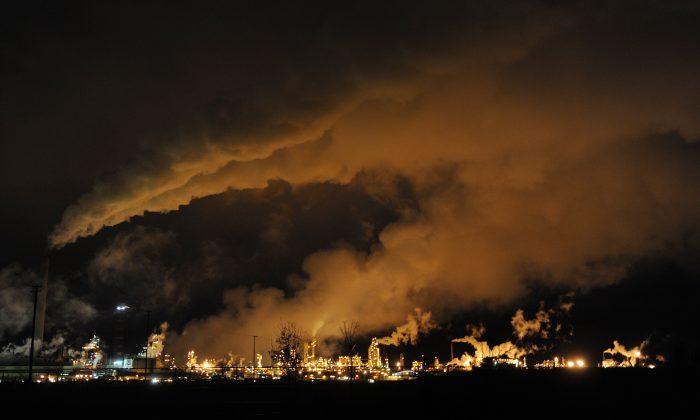Oil and gas prices are dropping rapidly and consumers are jumping for joy. But investors may be experiencing a little anxiety.
The business of oil production and whether or not it can sustain itself during this industry downturn relies upon two main factors—cost of production and return on investment.
Investors with interests in Canada and the United States, who are weighing their options in this volatile market, may consider choosing one country’s oil production method over the other. It’s important to understand that the oil production business in these two countries is very different, yielding equally different results.
Oil Sands
Oil sands are generally found in Canada, specifically in the oil-rich province of Alberta. Oil sands, or tar sands, which resemble coal, is a mixture of clay, sand, and bitumen (a heavy black sticky oil). It is mined and processed to extract oil similar to what is extracted from conventional wells. According to the U.S. Department of Interior’s Oil Shale and Tar Sands Programmatic EIS Information Center website, “Oil sands recovery processes include extraction and separation systems to separate the bitumen from the clay, sand, and water that make up the tar sands.”
Open pit mining techniques “use large hydraulic and electrically powered shovels to dig up tar sands.” The tar sands are then trucked to a facility where the separation process is conducted. This process, which results in a crude oil knock off, is criticized because of the difficulty in melting the nearly solid bitumen into a substance that is difficult to convert into fuel.
This form of oil production requires huge upfront costs, but once the operation is established, the oil can continue to be produced for years.
Shale Oil
Much of the recent U.S. oil industry boom in the plains states such as North Dakota, Texas, and Louisiana involve shale rock formations. Shale oil wells are created through the use of two technologies, hydraulic fracturing or fracking and horizontal drilling. The U.S. Environmental Protection Agency describes fracking as a process that “involves the pressurized injection of fluids commonly made up of water and chemical additives into a geologic formation. The pressure exceeds the rock strength and the fluid opens or enlarges fractures in the rock.”
The wells are then drilled horizontally to lengths that can extend several thousand feet.
This method also requires digging pool wells to collect the flowback liquids, and involves significant costs. It is criticized because the wells don’t usually produce oil for years. Some critics say the wells’ production reduces by 65 percent after the first year.
Experts
Tim Gramatovich, chief investment officer of California-based Peritus Asset Management told CBC News that he went to Calgary, Alberta in search of bargains.
Gramatovich is buying distressed debt and he knows that oil sands companies borrowed a lot of money in the beginning, so now that the prices have dropped, it is harder for them to service the debt. And that creates opportunities to snap up these securities at fire-sale prices.
“What we’re looking for is opportunity sets both in the debt and equity markets,” he said.
Chris Rockers, an energy investment banker with Colorado-based Alpina Capital, does not buy the argument that investors should be more interested in the oil sands business.
“Cost versus production is the determining factor when considering investment,” Rockers told the Epoch Times. He said the distressed investor operation is not his kind of business.
“Distressed play… buy the debt and if they can’t service the debt, it goes into either a pre-bankruptcy or bankruptcy situation. The debt holders now have the ability to potentially control the restructuring of the company or whatever they are investing in,” he said.
But that’s exactly what Gramatovich relishes. He’s counting on oil prices not staying low for very long. “Oil prices are unsustainable at these levels for any length of time,” Gramatovich said. He prefers to invest in oil sands projects because he views them as more viable in the long term with slow declines in reserves.
“When you look at the U.S. shale business, what do you own? What you own is a bunch of rocks that require an incredible amount of money to extract the oil,” he said.
Other critics say the shale oil business is over drilling—digging additional wells looking for a sweet spot, which drives up costs.
Rockers, on the other hand, is not sure there is even that much opportunity for investment in Canada’s oil sands businesses, alluding to the possibility that the Canadian government holds certain authority over the industry.
The Financial Post reported that shares in oil sands companies declined between December 2012 and March 2014 by 20 percent after the government announced regulations that permitted a Chinese company to purchase a Calgary-based energy company, but limited further ownership of oil sands resources by state-owned firms.
In addition, Rockers calls oil sands businesses of Canada a “one trick pony,” explaining that they only focus on the local oil sands project, while U.S. shale companies like Anadarko Petroleum Company has more than one focus, including overseas investments, which means more diversification for cash flow generation.
He also doesn’t agree that shale production investments are just a bunch of rocks. Shale wells have “higher initial productions with a pretty significant decline curve, but then again you can always go back and rework the well to enhance or create more oil production,” Rockers said.
He notes that the risk of dry holes is pretty low now that the geological science has been improved, so there’s less missing and more hitting.





Friends Read Free